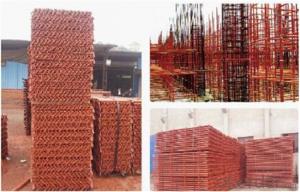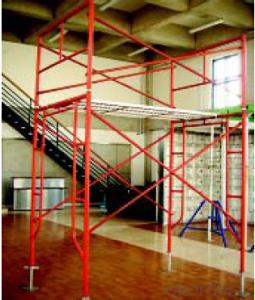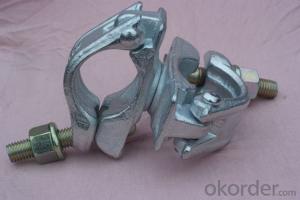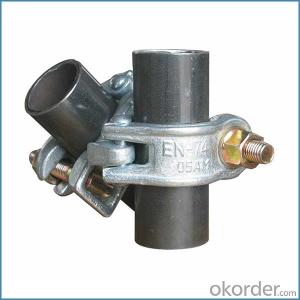Scaffold Drop Forged Double Coupler British Type for Sale
- Loading Port:
- Tianjin
- Payment Terms:
- TT OR LC
- Min Order Qty:
- 1000 kg
- Supply Capability:
- 100000 kg/month
OKorder Service Pledge
OKorder Financial Service
You Might Also Like
Scaffold Drop Forged Double Coupler British Type for Sale
Description
1.The scaffolding coupler is always used to connect the steel pipe as scaffolding system.
2.The often used coupler is swivel coupler and righ angle coupler .
3.We can provide types of scaffolding coupler according to your requirement.
4.Couoler can fix the 48.3mm scaffolding steel pipe tightly and make the whole scaffolding system more steadily.
5.Material:Q235 steel
6.Overall Size:48.3mm*48.3mm
7.Surface Finish: Galvanized/ Painted
8.Standard:BS1139,EN74
9.Package:25pcs/bag
10.Manufactuering as per customer requirements

Feature
(1)Excellent Anti-Breaking—Cold Pressed Steel
(2)Outstanding Resistance Deformation
(3)Strong Anti-Dropping Ability
(4)Longtime USe
(5)Qualtity Guaranteed
(6)OEM Service
Photo



Parameter
| Material | Q235,345steel |
| Size | 48.3mm*48.3mm |
| Surface finish | Galvanized |
| Weight | 1.1kg around |
| Standard | BS1139,EN74 |
| Package | 25pcs/bag,steel pallet |
| Manufacture | As per customer requirement |
| Market | Africa, South America, the Middle East and Asia |
FAQ
Q: Are you a factory or trading company?
We are a state-owned corporation in China,dealing with various kinds of building materials.We have our holding subsidiaries.
Q: Where is your factory located? How can I visit there?
Our factory is located all around China.
Q: Can I get some samples?
Sample is free, customer only pay freight for the first time.
Q: Delivery?
10-30days. (5-15 containers)
Any question,feel free to contact us.
- Q: What are the common installation methods for steel tube couplers in scaffolding?
- There are several common installation methods for steel tube couplers in scaffolding, depending on the specific requirements and design of the scaffolding system. One of the most commonly used methods is the sleeve or compression method. In this method, the steel tube coupler is placed over the two tubes that need to be connected, and then tightened using bolts or nuts. This creates a secure and rigid connection between the tubes, ensuring stability and safety in the scaffolding structure. Another method is the swivel method, which is used when a flexible joint is required in the scaffolding system. In this method, the steel tube coupler is designed with a swivel mechanism that allows the connected tubes to rotate or pivot. This is particularly useful in situations where the scaffolding needs to adjust to uneven surfaces or changes in angles. Additionally, the wedge method is commonly used for quick and easy installation of steel tube couplers. In this method, the coupler is placed between the tubes, and a wedge is inserted to secure the connection. This method is efficient and time-saving, making it ideal for large-scale scaffolding projects. It is worth mentioning that regardless of the installation method used, it is essential to ensure that the steel tube couplers are properly aligned and tightened to the recommended torque specifications. This will guarantee the structural integrity of the scaffolding system and ensure the safety of workers using the scaffolding.
- Q: Are there any specific guidelines for the safe use of steel tube couplers in scaffolding systems with overhead hazards?
- There exist specific guidelines for ensuring the safe use of steel tube couplers in scaffolding systems with overhead hazards. Here are several key guidelines that should be adhered to: 1. Thorough inspection: Prior to employing steel tube couplers, a comprehensive inspection should be conducted to identify any signs of damage or corrosion. Any couplers displaying signs of wear and tear or damage should be promptly replaced. 2. Load capacity awareness: It is of utmost importance to comprehend and acknowledge the load capacity of the steel tube couplers being utilized. It is crucial to utilize couplers that are rated to bear the anticipated load, including any additional weight caused by overhead hazards. 3. Secure connections: All steel tube couplers must be properly connected and tightened to establish a secure and stable scaffolding structure. Loose or improperly connected couplers can result in instability and accidents. 4. Assessment of overhead hazards: Prior to erecting scaffolding with steel tube couplers, a thorough assessment of the overhead hazards within the work area should be conducted. This may involve identifying potential falling objects, overhead equipment, or other obstructions that may pose a risk to the scaffolding system. 5. Implementation of protective measures: Adequate protective measures should be implemented to prevent accidents caused by overhead hazards. This may entail the installation of overhead protection systems such as debris nets, catch platforms, or toe boards. 6. Proper training: All workers involved in scaffolding operations with steel tube couplers must receive appropriate training on their safe use. This includes training on how to inspect, assemble, and dismantle the scaffolding, as well as how to respond in the event of an overhead hazard. 7. Compliance with regulations: Adherence to all pertinent safety regulations and standards regarding the use of steel tube couplers in scaffolding systems is crucial. These regulations may vary depending on the jurisdiction, necessitating the need to remain updated with the latest guidelines. By adhering to these specific guidelines, the safety of scaffolding systems utilizing steel tube couplers in environments with overhead hazards can be enhanced, and the risk of accidents or injuries can be minimized. It is always advisable to seek guidance from a qualified scaffolding professional or safety expert who can provide specific recommendations based on the unique requirements of your worksite.
- Q: How do steel tube couplers contribute to the overall stability of a scaffolding structure during construction activities?
- The overall stability of a scaffolding structure during construction activities relies heavily on steel tube couplers. These couplers are crucial for connecting and securing the steel tubes that form the scaffolding system's framework. A significant contribution of steel tube couplers to scaffolding structure stability lies in their capacity to establish robust and inflexible connections between the tubes. The design of these couplers ensures a tight grip on the tubes, effectively keeping them in place. This guarantees that the tubes remain immobile, which is vital for maintaining the scaffolding structure's stability and integrity. Moreover, steel tube couplers are engineered to evenly distribute the load across the connected tubes. This minimizes stress concentration points and ensures an even distribution of the scaffolding system's weight. By achieving this balance, the couplers prevent excessive stress or strain on individual tubes, thereby reducing the risk of failure or collapse. Furthermore, steel tube couplers offer versatility, allowing for various connections and configurations within the scaffolding structure. Whether it involves connecting tubes at right angles, creating diagonal bracing, or joining different sections of the scaffolding, these couplers offer the necessary flexibility and adaptability. This enables the construction of scaffolding structures capable of withstanding different loads, heights, and configurations, thereby further enhancing their stability and safety. Overall, steel tube couplers are an indispensable component in ensuring the stability of scaffolding structures during construction activities. Their capacity to establish strong and inflexible connections, evenly distribute load, and provide versatility makes them an essential element in safeguarding the integrity and safety of scaffolding systems.
- Q: Can steel tube couplers be used in scaffolding projects with complex geometries?
- Indeed, complex scaffolding projects can benefit from the utilization of steel tube couplers. These couplers possess a remarkable adaptability, enabling the connection of tubes at various angles and positions, thus facilitating the construction of intricate scaffold structures. Designed to ensure robust and secure connections, these couplers guarantee the stability and safety of the scaffolding system, even in the face of complex geometries. Furthermore, installing steel tube couplers is a straightforward task, and they can be effortlessly adjusted and repositioned as necessary, making them ideal for accommodating the evolving demands of intricate scaffolding projects.
- Q: Are there any specific standards or regulations for steel tube couplers used in scaffolding?
- Yes, there are specific standards and regulations for steel tube couplers used in scaffolding. These standards and regulations are established by various organizations such as the American National Standards Institute (ANSI), Occupational Safety and Health Administration (OSHA), and the British Standards Institution (BSI). These standards ensure that steel tube couplers meet certain requirements for strength, durability, and safety in scaffolding applications. Compliance with these standards is essential to ensure the integrity and stability of scaffolding structures.
- Q: Are steel tube couplers compatible with different types of scaffolding systems?
- Yes, steel tube couplers are compatible with different types of scaffolding systems. They are designed to securely connect steel tubes used in scaffolding, regardless of the specific type or brand of the scaffolding system.
- Q: How are steel tube couplers inspected for safety and durability?
- Steel tube couplers are inspected for safety and durability through a rigorous testing process. This process involves a combination of visual inspections and mechanical tests to ensure that the couplers meet the required standards. During visual inspections, trained professionals carefully examine the couplers for any visible signs of defects, such as cracks, corrosion, or damage. This step is crucial as it helps identify any surface irregularities that could compromise the safety and durability of the couplers. Mechanical tests are also conducted to assess the strength and performance of the steel tube couplers. These tests involve subjecting the couplers to various load conditions, such as tension, compression, and bending, to simulate the real-world operating conditions. The couplers are tested to ensure that they can withstand the specified loads without failure or deformation. In addition to these standard tests, steel tube couplers may also undergo non-destructive testing methods, such as ultrasonic testing or magnetic particle inspection. These techniques allow for the detection of any hidden defects or internal flaws that may not be visible to the naked eye. Furthermore, the manufacturing process of steel tube couplers is closely monitored to ensure proper quality control. This involves maintaining strict adherence to industry standards and guidelines, as well as conducting regular audits and inspections of the production facilities. Overall, the inspection process for steel tube couplers involves a comprehensive evaluation of both their visual appearance and mechanical properties. By utilizing a combination of visual inspections, mechanical tests, and non-destructive testing methods, the safety and durability of the couplers can be effectively assessed, ensuring their reliability in various applications.
- Q: What are the typical weight limits for steel tube couplers in scaffolding applications?
- The weight limits for steel tube couplers in scaffolding applications can vary depending on the specific type and design of the coupler. However, generally speaking, steel tube couplers used in scaffolding are designed to handle heavy loads and support significant weight. Take, for instance, a standard forged steel sleeve coupler, which is commonly employed in scaffold connections. Typically, it has a maximum load rating of about 3,000 pounds (1,360 kilograms). This means that when properly installed and used with other couplers and scaffolding components, each coupler can support this amount of weight. It is worth noting that weight limits for steel tube couplers are affected by several factors, including the diameter and thickness of the connected tubes, the type of scaffolding system in use, and the overall design and integrity of the entire scaffolding structure. Therefore, it is crucial to adhere to the manufacturer's specifications and guidelines, as well as any relevant local regulations, to ensure the safe and correct utilization of steel tube couplers in scaffolding applications. In any case, it is always wise to consult with a qualified scaffolding engineer or a reputable supplier to determine the specific weight limits and load-bearing capacities of steel tube couplers for your particular scaffolding project.
- Q: What are the common quality control measures for steel tube couplers?
- Some common quality control measures for steel tube couplers include: 1. Dimensional checks: This involves verifying the dimensions of the couplers, such as inner and outer diameter, length, and thread size, against the specified tolerances. This ensures that the couplers will fit properly and securely with the steel tubes. 2. Visual inspection: Couplers are visually inspected for any visible defects, such as cracks, dents, or deformations. This helps ensure that the couplers are free from any visible flaws that could compromise their structural integrity. 3. Material testing: Samples of the steel used to manufacture the couplers are often tested for their chemical composition, mechanical properties, and microstructure. This ensures that the material meets the required standards for strength, durability, and corrosion resistance. 4. Strength and load testing: Couplers are subjected to various strength and load tests to evaluate their performance under different conditions. This may include tests to determine their tensile strength, torque resistance, and ability to withstand axial or radial loads. These tests help ensure that the couplers can safely handle the expected loads and forces in real-world applications. 5. Surface finish inspection: The surface finish of the couplers is inspected for any imperfections, such as burrs, scratches, or roughness. This is important to ensure that the couplers have a smooth surface that will not cause damage to the steel tubes or affect their structural integrity. 6. Thread inspection: For threaded couplers, the threads are inspected to ensure that they are properly formed, aligned, and free from any defects. This is crucial for achieving a secure and leak-free connection between the couplers and the steel tubes. 7. Corrosion resistance testing: Couplers may undergo corrosion resistance testing to evaluate their ability to withstand exposure to various environmental conditions. This helps ensure that the couplers will have a long service life and maintain their structural integrity even in corrosive environments. By implementing these quality control measures, manufacturers can ensure that steel tube couplers meet the required standards and specifications, providing reliable and safe connections in various applications.
- Q: I got a scaffold piercing 2 days ago, how long will it be swollen for?
- It sounds such as you have a contaminated piercing website. you will possibly desire to get a physician to look at this as there must be a situation. Are you specific that the kit that became used to pierce your ears have been thoroughly sparkling? If no longer, you will possibly have an infection from it. wish that this permits:)
Send your message to us
Scaffold Drop Forged Double Coupler British Type for Sale
- Loading Port:
- Tianjin
- Payment Terms:
- TT OR LC
- Min Order Qty:
- 1000 kg
- Supply Capability:
- 100000 kg/month
OKorder Service Pledge
OKorder Financial Service
Similar products
Hot products
Hot Searches
Related keywords




























